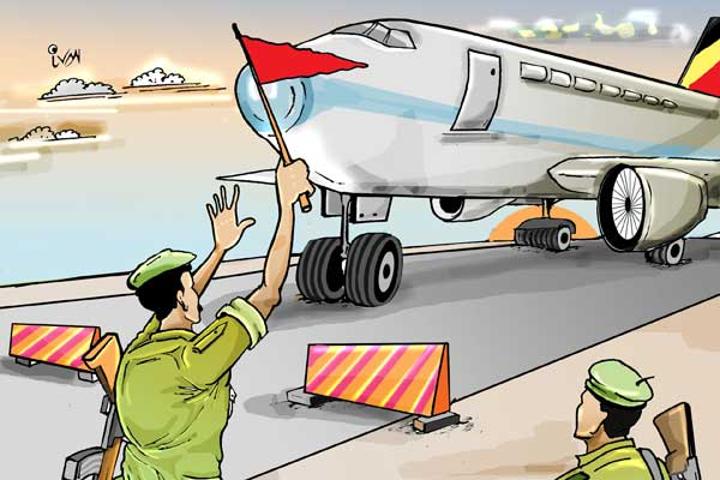Africa-Press – Uganda. This month marked 30 years since a Uganda Airlines passenger plane, a Boeing 707, was intercepted in Yugoslavia airspace and seized.
We marked this anniversary at a time when there is an ongoing investigation into allegations of corruption at the national carrier.
The plane which was impounded was one of two Boeing 707-338cs, which former president Idi Amin bought for purposes of operating long haul flights to Europe and the Middle East.
Long haul flights were, however, stopped a few months after the October 17, 1988, incident when one of the two Boeings crashed while attempting to land at Rome Fiumicino Airport in Italy, claiming the lives of 33 of the 52 people on board, including the pilot, Capt Steven Walusimbi, and his seven-man crew.
Two Mig-21 fighter jets belonging to Yugoslavia’s federal air force intercepted the Boeing and forced it to land at Zagreb, the capital of Croatia.
According to Capt Edward Francis Babu, a former Uganda Airlines pilot who retired into politics and business, it is standard practice for one to ask for permission to land at any given airport.
“To land in a place you need permission.
And you have got to give them what they call a manifest. Whether you have passengers or you have cargo and what type of cargo,” Capt Babu explains.
Capt Steven Makyeli requested for an emergency landing in order to refuel at Ljubljana, the capital of Slovenia.
It is not clear whether permission to overfly Yugoslavia with that tranche of arms had earlier been granted.
“The country where you are coming from with your arms is meant to inform the country that you are going to overfly that these guys are carrying cargo of this nature. If they do not give you permission to overfly, they will ask you to land. If you are on the ground they will not allow you to take off,” Capt Babu further explains.
“Whenever you have arms, you need special permission to overfly and to land. Carrying weapons into a war zone is usually very dangerous. You do not even get insurance for it,” he adds.
Attempts had been made to cover up the fact that weapons were on board.
According to what the Baltimore Sun reported in the story, ‘Illegal arms traders train sights on Yugoslavia’ which was published on September 1, 1991, Capt Makyeli told authorities in Yugoslavia that he was carrying “technical equipment”, but the explanation did not wash with the guys at the Yugoslav air force headquarters.
The air force honchos then deployed the fighter jets to escort the Boeing to another airfield in Zagreb, where the actual cargo was ascertained.
The flight manifest had also been falsified to describe the shipment as “technical equipment”, but what was instead found was a shipment of 18 tonnes of weapons, including 520 Singapore-made SAR-80 automatic rifles, 1,350 rifle- launched grenades and 621,000 rounds of ammunition.
The arms were at the time valued at $1.1 million, just under Shs3.9 billion.
The impounded arms were only a part of a total batch of arms worth $2.5 million that Mr Anton Kikas, a Toronto-based Croatia born businessman with dual citizenship, had purchased through a Vienna, Austria, based arms dealer, One Michael Flobber.
South Africa denies
How the arms dealer obtained the arms remains a mystery. The South African government’s state-run arms company, Armscor, was quick to issue a statement denying involvement in the deal.
‘‘We have no contract with Yugoslavia nor have we made any shipments to Yugoslavia or any parties within the boundaries,” it said. The arms had been destined for Croatia.
Croatia had at the time declared semi autonomy from the Yugoslavian federation, but its security forces numbered on 16,000 at the time of the declaration. Large parts of the country were occupied by Serbians who were opposed to the aspirations of the Croats, compelling them to increase the number of men under arms.
And since the population of Serbia was almost twice that of Croatia, the Croats agreed to a plan to hand out arms to every able-bodied person in preparation for war.
The number had by August 1991 reached 105,000, but that also meant that the country required more arms. That precipitated a fundraising drive that saw Croats living in Europe and the North America to raise funds through organisations such as the Croatian National Fund in Canada.
Kikas is said to have first accessed a plane provided by top Croatian government officials, but the attempt to get arms from Budapest, Hungary, was futile.
Ugandan connection
Col Miodrag Starcevic, the spokesperson of the Yugoslavian government at the time, said it was after hitting a dead end in Hungary that Mr Kikas hooked up with Mr Flobber in Vienna from where he flew to South Africa.
It was not possible to talk to Capt Makyeli for this article, but Col Starcevic told the media in Belgrade that Uganda Airlines plane flew to Mmabatho, near Johannesburg, from which Mr Kikas was picked up.
It then flew to Maputo, in Mozambique, where the arms were loaded before it flew back to Entebbe, taking off for Yugoslavia on the night of August 31.
Capt Mike Mukula, another retired former pilot, says flights between countries are normally arranged under bilateral air service agreements, under which the number of times one airline can fly and land into a destination in another country are arrived it.
The case of this particular flight has, however, turned out to be quite interesting. Whereas Uganda had and still has a bilateral air service agreement with South Africa, it does not have one with Mozambique. It, therefore, is still a bit strange that the plane flew into Mozambique before returning to Uganda.
The state denied knowledge of the transaction. It is still not clear how aviation security could have missed what was going on, especially that the plane spent a night at the airport before making the fateful flight to Belgrade on the night of August 31.
Could it be that Capt Makyeli had taken advantage of the management crisis in which the airline had been plunged and flown out of Entebbe without the knowledge of the management team? Mr Mukula says such a development would be practically impossible.
“There are so many steps that one goes through before touching an aircraft. One gets clearance from the chief pilot who clears you to fly, then the director flight operations grants you permission to enter a plane. There is also the aviation security and the inspectors of Civil Aviation Authority. It is not possible that he could have flown out without their consent,” Capt Mukula says.
The Justice Julia Sebutinde commission of inquiry into corruption in the police heard in November 1994 that the killing on January 11, 1992, of John Begumisa, a former purchasing officer with the airline, could have been as a result of that deal.
We just might never know whether Begumisa was involved. We might also never know who else was involved, but the Belgrade debacle ended in tears for Capt Makeyli and the airline.
Capt Makyeli was fined $4,500 and the airline lost the Boeing.






